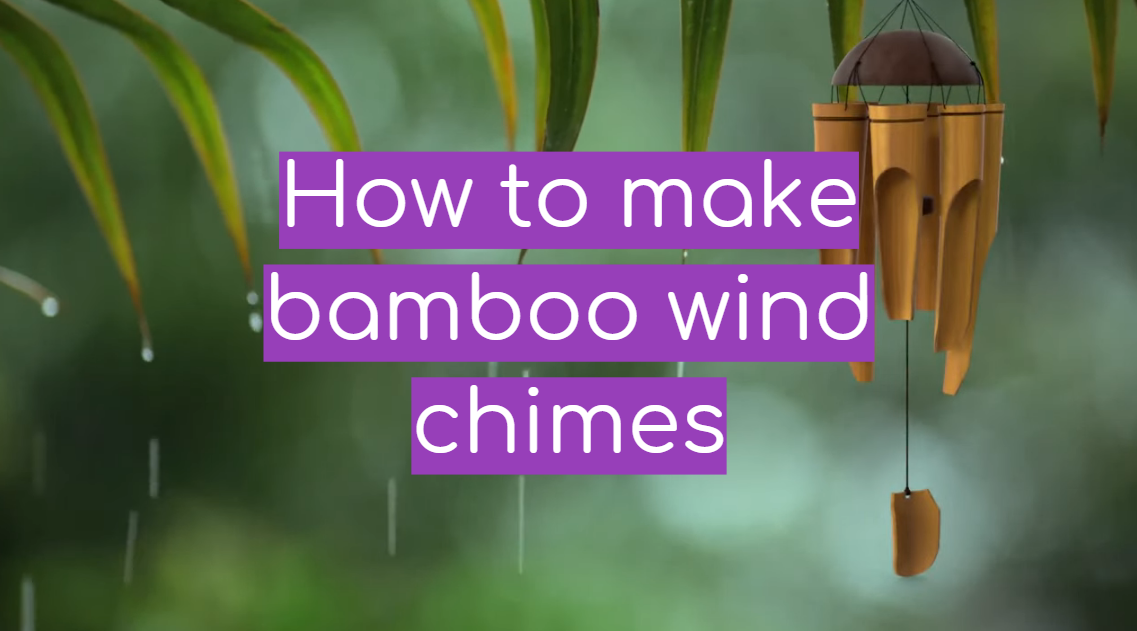Bamboo wind chimes as a piece of decoration will add natural features and quiet tones to your peaceful home atmosphere. You can purchase one in the store or try to make unique bamboo wind chimes on your own. Follow several simple steps of the guidelines below to create your personal natural piece of art.
Table of Contents
13-Step Guidelines on how to create your own bamboo wind chimes
Step 1 Get all the required materials
Not all of us live in the areas where wild bamboo grows. However, you can purchase bamboo poles intended for fishing at specialized stores, or you can come across bamboo at the stores of garden supplies, craft shops, or departments of home decor. The last but not least option is to go online.
Get ready for the project in advance. Prepare some bamboo poles, some thick plywood( the size depends on the size of the future instrument), a drill, a saw, some string, and a hot melt glue gun with glue.
Note! The bamboo material has to be seasoned well. Check if it isn’t rotten or split.
Step 2 Divide the bamboo into six sections of different lengths
Cut a bamboo pole into six pieces. Pay attention that each piece must have two sections of the plant. The first cutting line must be located slightly above the plant’s segment, while the other has to be slightly below the second segment. This way the piece of the tube will be open and easy to work with.
Step 3 Make a split on every piece
With a sharp knife split one end of every piece, which is hollow, to make it look sophisticated and produce incredible tunes. Here, very careful work is required as you can hurt yourself. If there is a vise at your disposal, use it to fix the bamboo pipe. It will make the job easier. Using a saw can be reasonable in case if the material is hard. Sharpen the last inch to make an angle.
Step 4 Drill the holes for hanging
With a small beat of 1/8 inch drill the holes above the segment on the opposite end of the pipe. The hole has to be parallel to the cut you have made in the previous step. After assembling you will see that such a construction allows every hollow channel of the bamboo pipe to face out on every piece.
Step 5 Prepare the top disc
Plywood or other similar material will do for the top. You must cut a circle seven times more than the diameter of a bamboo pipe. So, if you take 1-inch diameter pipes, the diameter of the round piece has to be 7 inches to be strong enough to hold the construction.
- Another interesting option is a triangle-shaped top made of reeds or twigs. The design is unbelievably simple. You can find the materials easily in your location. Arrange them in the form of a triangle. Secure the joints with hot glue and then wrap them with a string. Make it X-shaped at each corner for a more reliable hold.
If you have decided to use a triangular shaped top disc then you will need some twine. Cut it into nine pieces, an arm’s length each. Braid every three pieces and tie them to every corner of the triangular top. Make a knot at the end but leave approximately 4 inches of twine. Put your three braids together and make a loop at the end. Tie a knot to make it safe, as you will hang the whole unit with it.
This simple model doesn’t feature any striker or a sail. So just thread the string through the holes in the bamboo tubes and tie them to the triangle. Check if the pipes are close enough to each other. They have to collide when the wind starts to blow.
Step 6 Divide the top disc into six equal parts
This disc will hold the tubes so you have to layout 6 equal parts, like dividing a pie into pieces. Drill 12 1/8 inch holes on every side of the 6 layout lines, leaving 3/4 inch to the line. Remember to keep close to the edge of the piece.
Step 7 Thread the string through the holes
Take a long piece of string, like 48 inches long, thread it through the first hole and tie a knot to fix it. For the best results try to find a flexible string. Continue with the rest of the pipes doing it in turn. Go through the hole in the top, moving down and going through the bamboo pipe, and then moving up again to the top. Move around the circle to connect all the pipes to the disk. Tie off a string with a knot.
Step 8 Vary the position of pipes
Make some adjustments to place each stick lower or higher than the neighbors. With this simple trick the tone of each piece changes making unique sounds. Feel free with experiments to receive pleasure from the melody.
Step 9 Make three holes in the center of the disc
Drill three more holes in the middle, located around and equally at a distance of 1 ½ inch from the center. Cut 3 30-inches pieces of the string, tie the three together on one side to form a little loop.
Step 10 Insert the stripe pieces
Thread the cuts into three holes in the disc and fix them with hot melt glue to hold them in place. Remember to keep the disc level.
Step 11 Make the striker
Take a small piece of plywood and cut a disc which is smaller than the first one. It must be one and a half times bigger than the diameter of the bamboo pipes. Take a drill and make 3 1/8 inch holes located equally at the distance of about 1 inch from the central point. Now thread the ends of three central strings through the holes. Keep in mind that the distance between the top of the pipes and the striker is about ¼ of the lengths of the sticks. With the help of hot melt glue fix the string pieces to the round plywood disk, but this time keeping both discs level. This striker performs the function of a hammer and hits the pipes producing chime tunes.
Step 12 Make the sail
Use plywood or any other material to cut a preferred shape of a sail. Place it below the striker and tie it with all three string pieces. The sail catches the wind, makes the striker move back and forth, and hit the pipes. The size is important here. The sail of a bigger size sways easier even in a light breeze. But of course, it’s up to you, don’t be afraid to experiment with various shapes, sizes, and materials.
Step 13 Glue all the joints to secure the whole construction
Hot melt glue will help you again. Use it to fix all the joints, strings, and knots to have a reliable and well-tuned bamboo wind chime. Don’t limit your imagination and try to decorate your chimes anyway you like. You may add any embellishments. Some dried lavender or feathers can match the design.
Practical tips
- Don’t worry about bamboo. It can be dried and well seasoned or still green. The only point here is your skills and comfort at work. If you prefer working with fresh bamboo choose it. Afterward, leave it for a few days to dry and it will be ready.
- If you don’t split the bamboo ends it will affect the sounds your windchime produces. When the wind gets throughout the pipe it makes the sound loud and not so pleasant. It is recommended to split the pipe ends to make the melody smooth and relaxing.
- To test your bamboo wind chimes just hit the sticks to hear the sounds. The wind does it the same way. Remember that the lengths affect the pitch of the sound. The longer the stick, the higher the sound. And vice versa if the pipe is short the pitch will be lower and the sound deeper.
- While working with bamboo or other similar materials splinters can hurt or impale you. Be sure to wear special protection for your eyes and hands, for example, safety goggles and gloves if needed.
- Please note that you don’t have to hollow out the bamboo pipes. If you do this you can spoil the overall sound of the windchimes. The natural membrane functions as a drum, it captures the sound and then releases it slowly. If you clean the pipes, you will weaken the sound produced by the striker and make it escape quickly from the windchimes.
Comparison of Bamboo Wind Chime Making Indicators
Bamboo wind chimes are beautiful and environmentally friendly home decor items that can add a touch of serenity to any space. Making a bamboo wind chime can be a fun and rewarding DIY project, but it’s important to consider certain indicators to ensure that the final product is of high quality. In this table, we compare various indicators that are important in making bamboo wind chimes.
The table below compares four indicators for making bamboo wind chimes: the number of bamboo tubes, the diameter of each tube, the length of each tube, and the material used for the clapper. We compare these indicators for three different types of bamboo: Tonkin bamboo, Moso bamboo, and Giant bamboo. Tonkin bamboo is known for its thin and smooth-walled tubes, while Moso bamboo is thicker and has a rougher texture. Giant bamboo, as its name suggests, is the largest of the three and is often used for decorative purposes.
| Bamboo Type | Number of Tubes | Diameter of Each Tube (inches) | Length of Each Tube (inches) | Clapper Material |
|---|---|---|---|---|
| Tonkin Bamboo | 6 | 0.5 | 8-12 | Wood |
| Moso Bamboo | 5 | 0.75 | 10-14 | Metal |
| Giant Bamboo | 3 | 1.5 | 18-24 | Stone |
The table shows that the number, diameter, and length of bamboo tubes used in wind chimes vary depending on the type of bamboo used. The clapper material also differs, with wood being the most common for Tonkin bamboo, metal for Moso bamboo, and stone for Giant bamboo. It’s important to consider these indicators when making bamboo wind chimes to ensure that the final product looks and sounds beautiful.
FAQ
What materials do I need to make bamboo wind chimes?
To make bamboo wind chimes, you will need bamboo sticks, a saw, sandpaper, a drill, nylon or hemp cord, a metal ring or wooden disc, and a hammer. You may also want to decorate your wind chimes with beads, shells, or other embellishments.
How do I prepare the bamboo sticks for my wind chimes?
First, cut your bamboo sticks to the desired length using a saw. Sand down the rough edges with sandpaper. Then, use a drill to make a hole near the top of each bamboo stick. Make sure the hole is large enough to thread your cord through.
What’s the best way to assemble my bamboo wind chimes?
Start by tying a knot at the end of your cord, and then thread it through the metal ring or wooden disc. Next, tie a knot around each bamboo stick, leaving a few inches of cord between each one. To keep the bamboo sticks from clacking together in the wind, you can tie a bead or a shell between each one. Finally, tie a loop at the top of your cord so you can hang your wind chimes.
How can I tune my bamboo wind chimes?
You can tune your bamboo wind chimes by trimming the bamboo sticks to different lengths. Start by hanging your wind chimes and listening to the sound they make. If the chimes don’t sound quite right, you can trim the bamboo sticks with a saw until you achieve the desired pitch. Keep testing and adjusting until you’re happy with the sound.
Can I decorate my bamboo wind chimes?
Absolutely! Decorating your wind chimes can add a personal touch and make them more visually appealing. You can use beads, shells, feathers, or anything else that catches your eye. Just be sure to attach the decorations securely so they don’t fall off in the wind.
Where should I hang my bamboo wind chimes?
You can hang your bamboo wind chimes in a variety of locations, including your front porch, backyard, or garden. Just make sure they’re in a spot where they’ll catch the wind and make a pleasant sound. You may also want to consider hanging them near a window or doorway where you’ll be able to hear them more easily.
How do I care for my bamboo wind chimes?
To keep your bamboo wind chimes looking and sounding their best, you’ll want to take a few precautions. First, make sure they’re not exposed to extreme weather conditions, such as heavy rain or high winds. If you do need to take them down, store them in a dry place. You can also periodically clean your wind chimes by wiping them down with a damp cloth.
Can I make bamboo wind chimes with different sizes of bamboo sticks?
Yes, using bamboo sticks of different sizes can create a more varied and interesting sound. You can experiment with different lengths and diameters to create a unique melody. Just keep in mind that the thicker the bamboo stick, the deeper the sound it will produce.
What are some tips for making bamboo wind chimes?
Here are a few tips to keep in mind when making bamboo wind chimes:
- Choose high-quality bamboo that is straight and free of cracks or splits.
- Experiment with different lengths and diameters of bamboo to create a unique sound.
- Use a drill bit that is slightly larger than the cord you’re using to thread through the bamboo sticks.
- Be sure to tie knots securely to keep your wind chimes from falling apart in the wind.
- When tuning your wind chimes, start by trimming just a little bit off the bottom of each bamboo stick and testing the sound before trimming more.
Can I make bamboo wind chimes without a drill?
While a drill makes the process of making bamboo wind chimes easier, you can still make them without one. Instead of drilling holes in the bamboo sticks, you can tie the cord around the stick using a strong knot, such as a fisherman’s knot. Just be sure to leave enough cord to tie the next bamboo stick to the wind chime.
What are the benefits of making bamboo wind chimes?
Making bamboo wind chimes is a fun and rewarding DIY project that can provide several benefits. First, it can be a relaxing and meditative activity that allows you to unwind and tap into your creativity. Second, wind chimes can add a pleasing aesthetic element to your outdoor space, and the sound they make can help mask unpleasant noises, such as traffic or construction. Finally, because bamboo is a sustainable and renewable resource, making bamboo wind chimes is an eco-friendly way to decorate your home and garden.
Can I make bamboo wind chimes with kids?
Yes, making bamboo wind chimes can be a fun and educational activity to do with kids. However, it’s important to supervise them when using tools such as saws and drills, and make sure they understand how to use them safely. You may want to pre-cut the bamboo sticks for younger children, and let them sand down the edges and decorate the wind chimes with beads or shells.
How long does it take to make bamboo wind chimes?
The amount of time it takes to make bamboo wind chimes depends on your level of experience and the complexity of your design. Generally, it takes a few hours to cut and prepare the bamboo sticks, drill the holes, and assemble the wind chimes. Decorating the wind chimes with beads or other embellishments can add additional time.
What are some creative ways to display my bamboo wind chimes?
There are many creative ways to display your bamboo wind chimes. Here are a few ideas:
- Hang them from a tree branch or pergola in your garden.
- Attach them to the eaves of your roof using a hook or bracket.
- Hang them from a shepherd’s hook in a flower bed or near a pond.
- Mount them on a post or fence using brackets or clamps.
Can I sell my bamboo wind chimes?
Yes, you can sell your bamboo wind chimes if you’d like. However, keep in mind that there may be regulations or restrictions on selling handmade products in your area. You’ll also want to consider pricing your wind chimes fairly, taking into account the cost of materials and your time and labor.
Can I make bamboo wind chimes in different shapes?
Yes, you can experiment with different shapes and designs when making bamboo wind chimes. For example, you can create a spiral or helix shape by wrapping the bamboo sticks around a central post. You can also make a tiered wind chime by attaching multiple rows of bamboo sticks to a central cord or ring. The possibilities are endless!
Conclusion
The minimalist echo style of bamboo wind chimes makes it an exceptional addition to your decor wherever you place it at home or in your garden. Following the simple and detailed guidelines, you can create a special piece, which will please your eyes and caress your ears with magical tunes.






Leave a Reply